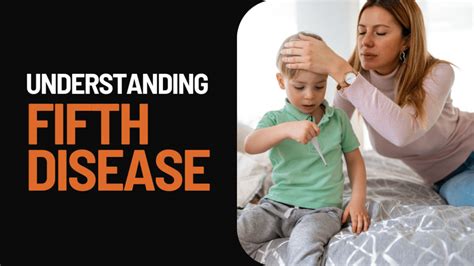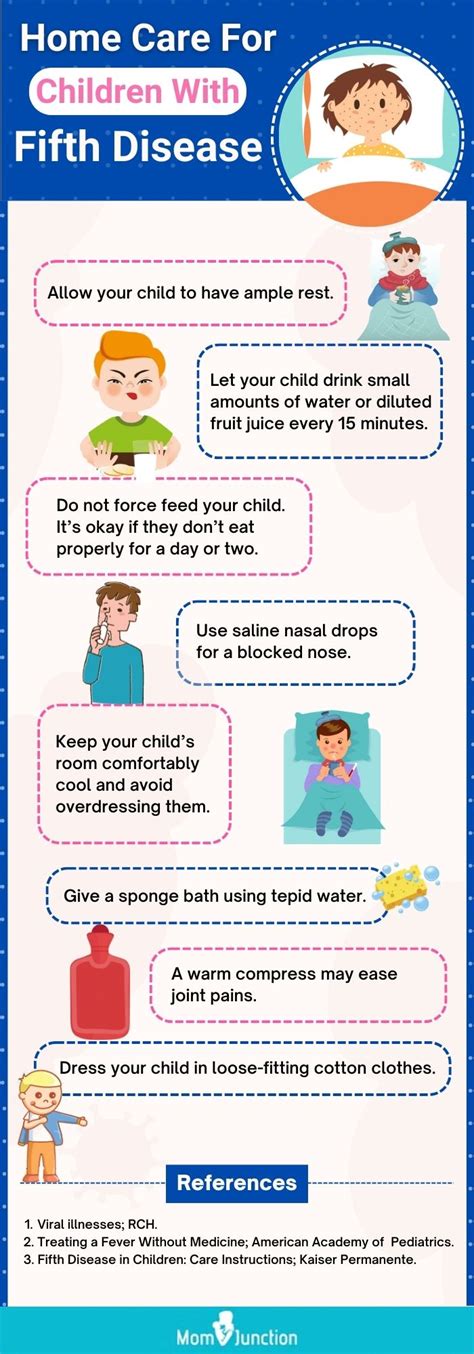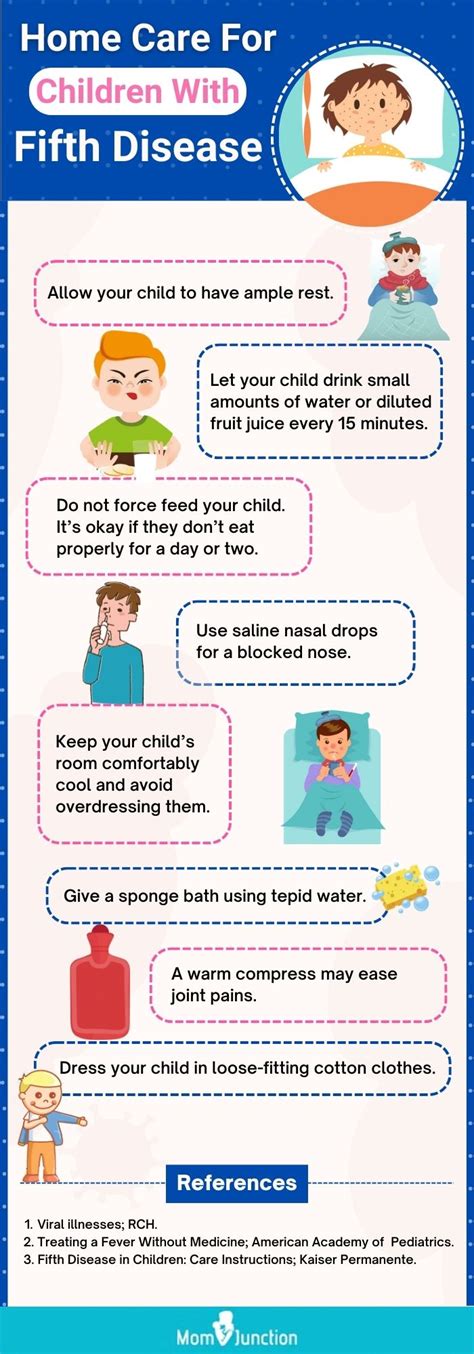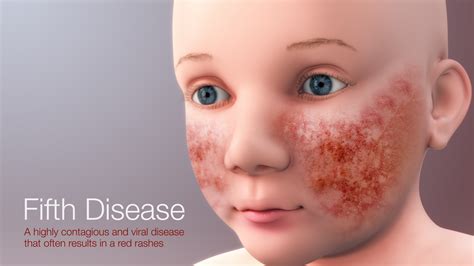Intro
Fifth disease, also known as erythema infectiosum, is a common and highly contagious viral infection that affects people of all ages, but it's most prevalent among children. The disease is characterized by a distinctive "slapped-cheek" rash, fever, and other flu-like symptoms. While there's no specific cure for fifth disease, there are several ways to treat its symptoms and reduce the risk of complications. In this article, we'll explore five ways to treat fifth disease, its causes, symptoms, and prevention methods.
The importance of understanding fifth disease lies in its ability to cause significant discomfort and, in some cases, serious health issues, especially for individuals with weakened immune systems. By recognizing the symptoms and taking prompt action, you can help alleviate the discomfort and prevent potential complications. Fifth disease is usually mild and resolves on its own within a week or two, but it's essential to take steps to manage the symptoms and prevent the spread of the infection.
Fifth disease is caused by the parvovirus B19, which is spread through respiratory secretions, such as saliva, sputum, and mucus, as well as through contact with contaminated surfaces. The virus can also be transmitted from a mother to her unborn child during pregnancy. The symptoms of fifth disease typically begin within 4-14 days after exposure to the virus and may include a low-grade fever, headache, fatigue, and a distinctive rash on the face, arms, and legs. In some cases, the rash may be itchy or uncomfortable, and it can take several weeks to resolve.
Understanding Fifth Disease

To effectively manage fifth disease, it's crucial to understand its causes, symptoms, and transmission methods. By recognizing the signs and symptoms of the disease, you can take prompt action to reduce the risk of complications and prevent the spread of the infection. Fifth disease is usually diagnosed based on the characteristic rash and other symptoms, and in some cases, a blood test may be performed to confirm the diagnosis.
Causes and Symptoms of Fifth Disease
The causes of fifth disease are attributed to the parvovirus B19, which is highly contagious and can be spread through various means. The symptoms of the disease typically begin within 4-14 days after exposure to the virus and may include a low-grade fever, headache, fatigue, and a distinctive rash on the face, arms, and legs. In some cases, the rash may be itchy or uncomfortable, and it can take several weeks to resolve.Treatment Options for Fifth Disease

While there's no specific cure for fifth disease, there are several treatment options available to manage its symptoms and reduce the risk of complications. The treatment options for fifth disease typically focus on alleviating the symptoms and supporting the body's immune system. Here are five ways to treat fifth disease:
- Over-the-counter medications: Over-the-counter medications, such as acetaminophen or ibuprofen, can help alleviate fever, headache, and body aches associated with fifth disease.
- Rest and hydration: Getting plenty of rest and staying hydrated can help support the body's immune system and reduce the severity of symptoms.
- Topical creams: Topical creams, such as calamine lotion or hydrocortisone cream, can help soothe the rash and reduce itching and discomfort.
- Antihistamines: Antihistamines, such as diphenhydramine, can help relieve itching and reduce the allergic response associated with the rash.
- Immune system support: Supporting the immune system through a healthy diet, supplements, and stress management can help the body recover from the infection and reduce the risk of complications.
Benefits of Treatment
The benefits of treating fifth disease include reducing the severity of symptoms, preventing complications, and supporting the body's immune system. By managing the symptoms and reducing the risk of complications, you can help alleviate the discomfort associated with the disease and prevent potential health issues.Prevention Methods for Fifth Disease

Preventing the spread of fifth disease is crucial to reducing the risk of complications and protecting vulnerable individuals, such as those with weakened immune systems. Here are some prevention methods for fifth disease:
- Practice good hygiene: Washing your hands frequently, especially after coming into contact with someone who has fifth disease, can help reduce the risk of transmission.
- Avoid close contact: Avoiding close contact with someone who has fifth disease can help reduce the risk of transmission.
- Clean and disinfect surfaces: Cleaning and disinfecting surfaces, especially in areas where someone with fifth disease has been, can help reduce the risk of transmission.
- Stay home when sick: Staying home when sick can help reduce the risk of transmission and prevent the spread of the infection.
Importance of Prevention
Preventing the spread of fifth disease is essential to reducing the risk of complications and protecting vulnerable individuals. By practicing good hygiene, avoiding close contact, cleaning and disinfecting surfaces, and staying home when sick, you can help reduce the risk of transmission and prevent potential health issues.Complications of Fifth Disease

While fifth disease is usually mild and resolves on its own within a week or two, there are potential complications that can arise, especially for individuals with weakened immune systems. Here are some complications of fifth disease:
- Anemia: Fifth disease can cause anemia, especially in individuals with weakened immune systems or underlying medical conditions.
- Arthritis: Fifth disease can cause arthritis, especially in adults.
- Infections: Fifth disease can increase the risk of infections, especially in individuals with weakened immune systems.
- Miscarriage: Fifth disease can increase the risk of miscarriage, especially during the first 20 weeks of pregnancy.
Risk Factors for Complications
The risk factors for complications from fifth disease include weakened immune systems, underlying medical conditions, and pregnancy. Individuals with weakened immune systems, such as those with HIV/AIDS or undergoing chemotherapy, are at a higher risk of complications from fifth disease. Additionally, individuals with underlying medical conditions, such as anemia or arthritis, are at a higher risk of complications.Conclusion and Next Steps

In conclusion, fifth disease is a common and highly contagious viral infection that affects people of all ages. While there's no specific cure for the disease, there are several treatment options available to manage its symptoms and reduce the risk of complications. By understanding the causes, symptoms, and transmission methods of fifth disease, you can take prompt action to reduce the risk of complications and prevent the spread of the infection. If you suspect you or your child has fifth disease, it's essential to consult with a healthcare professional for proper diagnosis and treatment.
We invite you to share your thoughts and experiences with fifth disease in the comments section below. Have you or your child had fifth disease? What were your symptoms, and how did you manage them? Share your story to help others understand and cope with the disease.
What are the symptoms of fifth disease?
+The symptoms of fifth disease typically include a low-grade fever, headache, fatigue, and a distinctive rash on the face, arms, and legs.
How is fifth disease transmitted?
+Fifth disease is transmitted through respiratory secretions, such as saliva, sputum, and mucus, as well as through contact with contaminated surfaces.
Can fifth disease be prevented?
+While there's no specific vaccine for fifth disease, practicing good hygiene, avoiding close contact, cleaning and disinfecting surfaces, and staying home when sick can help reduce the risk of transmission.
What are the complications of fifth disease?
+The complications of fifth disease can include anemia, arthritis, infections, and miscarriage, especially in individuals with weakened immune systems or underlying medical conditions.
How is fifth disease diagnosed?
+Fifth disease is usually diagnosed based on the characteristic rash and other symptoms, and in some cases, a blood test may be performed to confirm the diagnosis.
